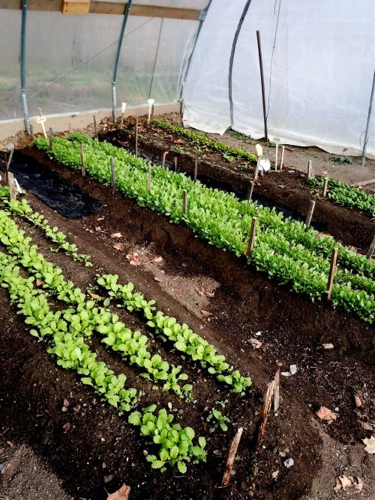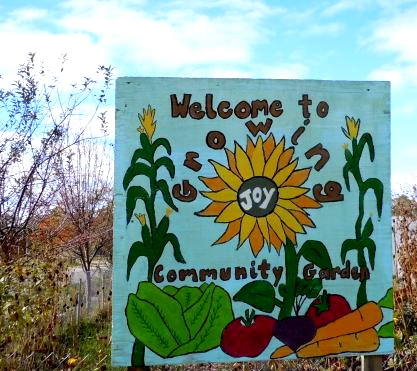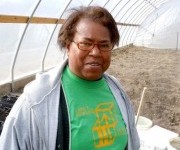 Photo: Patrick CrouchEdith Floyd is the real deal. With little in the way of funding or organizational infrastructure, she runs Growing Joy Community Garden on the northeast side of Detroit. Not many folks bother to venture out to her neighborhood, but Edith has been inspiring me for years. I caught up with her on a cold, rainy November afternoon. While we talked in the dining room, her husband Henry watched their grandkids.
Photo: Patrick CrouchEdith Floyd is the real deal. With little in the way of funding or organizational infrastructure, she runs Growing Joy Community Garden on the northeast side of Detroit. Not many folks bother to venture out to her neighborhood, but Edith has been inspiring me for years. I caught up with her on a cold, rainy November afternoon. While we talked in the dining room, her husband Henry watched their grandkids.
Q. You haven’t always been an urban farmer. What did you do before this?
A. I worked at Detroit Public Schools. I started out with the Head Start Center and then I went to the middle school, to the Ed Tech, [which is] now the Computer Lab. I started farming because they laid me off and didn’t call me back. Farming is not making a living, it’s just keeping food in my freezer. I try to sell some so I can get some more equipment, so it will be easier for me to farm.
Q. What neighborhood are we in? What is it like?
A. This is the northeast side — near the city airport. It’s surrounded by graveyards on three sides and then the other barrier is the railroad track; we are surrounded by railroad tracks, and sometimes those trains stay for like 30 minutes, so you are trapped; ain’t no way out.
Q. How long have you lived in this neighborhood?
A. Let’s see. I came here when my son was 4, so about 36, 37 years.
Q. So you’ve seen a lot of changes.
A. Yeah, when I came it was beautiful — there were grocery stores in the center, like in the middle of the neighborhood, but when the city came though here and bought everything up, they said [they were going to] enlarge the city airport. They bought up three and four blocks of houses and then left the rest of them there. They came in and ruined our neighborhood, and said they ran out of money and left us over here like that. I’m still here and I’m gonna stay here, ’cause I don’t want to go somewhere and start all over again. I don’t think I’d be able to pay for another house, and this one is already paid for. There was like 66 houses on this block, and now [there are] about six that people live in, and three need to be torn down, and the rest of it is empty. That’s where I’m putting my farm on, all the lots. [Editor’s note: some are calling this practice “blotting.” Here’s a recent NPR story on blotting in Detroit.]
Q. How many lots are you farming now?
A. It’s like 28 lots.
Q. What are you growing on those lots?
 Photo: Patrick CrouchA: Across the street I have my strawberry lot. I try to plant by lot. I have a collard green lot, a kale lot, an okra lot, an eggplant lot, green bean lot. I had a corn lot, but it didn’t work so well. Right now I have a garlic lot, I had a tomato lot, cucumber lot, squash, cabbage, broccoli, watermelon, cantaloupe. I like flowers, so I planted some of them. I had potatoes, mustard greens, turnip greens.
Photo: Patrick CrouchA: Across the street I have my strawberry lot. I try to plant by lot. I have a collard green lot, a kale lot, an okra lot, an eggplant lot, green bean lot. I had a corn lot, but it didn’t work so well. Right now I have a garlic lot, I had a tomato lot, cucumber lot, squash, cabbage, broccoli, watermelon, cantaloupe. I like flowers, so I planted some of them. I had potatoes, mustard greens, turnip greens.
Q. That’s a lot of food!
A. Well, if it comes up it’s a lot, but I give some to the Capuchin Soup Kitchen. I sell some at Eastern Market, and Wayne State Market, but the cabbage does not sell so I don’t take cabbage there. (I still have about two of 300 pounds of cabbage I need to harvest.)
Q. So how much money are you making in a season?
A. I was trying to reach for 3,000, but I only made it to two something. I have to add up the last bit; I haven’t got my last check. Every year I try to up it; the first year I made 1,000. The second year I went 2,000; this year I was trying to go for $3,000.
Q. So 28 lots, $3,000 — that’s a lot of work. Aren’t there easier ways to make money?
A. Well, I’m not doing this just to make money! I’m doing this because I love it. I love to see things grow from seeds.
Q. Do you come from a farming family?
A. Yeah, I grew up in a family that sharecropped, you know, the old-fashioned way. Near Orangeburg, S.C., but we lived out in the country, out close to the swamp. When our house burned down, a guy offered that if my dad worked for him, then we could stay in his house for free, because he had another house …The first year we worked our behinds off, we farmed 300 to 400 acres of cotton, plus the wheat, rye, oats, and corn. When you sharecrop you do the work, you get half the crop, and you split the cost of the fertilizer. After the first year we didn’t make nothing! After that first year, he would just take a bunch of cotton and hide it in the woods, or we wouldn’t make a dime. My mother always canned and had a lot of food so she always had like 500 jars of tomatoes, corn, squash, everything. She kept enough food to eat, and even had enough to feed the neighbor[s’ family], and he had 12 kids.
I think that’s the best time of my life, because we learned how to get food out of the woods, like all kinds of berries; gooseberries, blackberries, raspberry, strawberry, plums, and these little black berries we called sparkleberries.
We would collect hickory, walnuts, and pecans. My mama would make us get big five gallon buckets and crack them and she would make fruit cakes. She would add a little dried fruit, but mostly it was nuts. They were good.
Q. So why did your family move up to Detroit?
A. They didn’t, just me! I came for one summer to stay with my aunt, and somehow my daddy talked them into having me stay, saying it’s better for me, and I don’t have to work. But I thought work was fun then.
 Photo: Patrick Crouch[My aunt] had a store and I would work there before school and after school. Then I met my husband and he would walk me to school every day; he was there when I got out of school to walk me back home. That was nice because at the time it was the riot.
Photo: Patrick Crouch[My aunt] had a store and I would work there before school and after school. Then I met my husband and he would walk me to school every day; he was there when I got out of school to walk me back home. That was nice because at the time it was the riot.
When we got married and moved to this neighborhood, we were the second black family on the street. It was so beautiful, there were houses everywhere, an apartment building down there, a restaurant, barber shop, hardware store, a bar, a steakhouse. There was a greenhouse with lots of flowers and plants, and a welding shop. We got along real well on this street until Devil’s Night started. Then they started lighting fires. We would stay up just about all night watching for fires, cause the houses were so close together, and the next day we would sleep. Mostly the teenagers would start fires. We had a nice big garage that you could drive your car into, with an apartment upstairs. They burned that down, and the one next door. Then people started moving out, and I didn’t blame them.
Then the [General Motors] Hamtramck plant closed and the rest of the people moved out because they lost their houses. They would pay somebody to burn it down to get insurance money, and they’d take the money and go. My husband got laid off for about a year, but they called him back. After that people just started moving out one by one until just about everyone was gone. All the younger people are gone, one or two older people are still here. Me and the girl next door and the people down the street are about my age, some are a little older. The rest are gone. I’m not gonna try and run with the rest of them, I just want to plant some food. Every time a house comes down I try to dig it out and plant some food, so that’s how I started.
When I first came over here I had a garden in the backyard, and when people started moving out, I started one lot, then moved on to the next lot, and I kept at it. Three years ago I started the lot where the greenhouse is. It still has a lot of rocks, and I’m still trying to get the dirt better. I’m trying to get more leaves and grass so I can make a big compost pile.
I found out that tomatoes will grow anywhere. I don’t care what kind of dirt you put tomatoes in, they will grow. String beans and okra will grow anywhere, and lima beans and peas, but they are slow-growing.
I’m really hoping the city will give me some answers. I want to buy the land, but I don’t know.
Q. What’s next for the farm?
A. The big plan is to have them let me close everything down and plow it all up. I want to go clear down to the five-acre park at the end of the street. You can’t really make too much with beans or peas unless you have an acre or more. I had one lot with lima beans and I [harvested] about 100 quarts off the one lot, and I would have had more if I had planted earlier.



